Farmers market gets brief mention at Bloomington 2021 budget hearings, still “elephant in room”
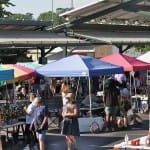
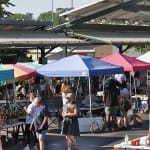

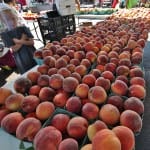
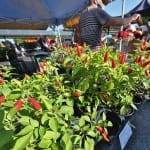
Last Wednesday was the Bloomington city council’s third night in a series of four hearings on the proposed 2021 budget.
Appearing on Wednesday’s agenda was the 2021 budget for the parks and recreation department, which again includes the city’s community farmers market. The origin story for the market dates back to 1975.
The market has been the subject of controversy since early in last year’s season, when a vendor with ties to white supremacist groups was identified by local activists. A lawsuit filed by the vendor and a counterclaim by the city is pending in federal court, with a trial date set for over a year from now.
Based on the opposing views of long-time councilmembers Isabel Piedmont-Smith and Dave Rollo, it would likely take a hard political fight to remove the farmers market from the city’s currently proposed 2021 budget.
A fight over the farmers market could take place behind closed doors—between councilmembers and the mayor—before Sept. 30, when the administration’s final version of budget is presented to the council. A vote to adopt the budget is scheduled for Oct. 14.
Or the debate could take place in public, if a councilmember proposes an amendment to the final 2021 budget that would defund the farmers market.
Also a possibility is that the farmers market remains, as councilmember Kate Rosenbarger put it on Wednesday, “the elephant in the room.”
The farmers market budget is in the ballpark of $150,000, or less than a tenth of one percent of the total city budget, if utilities and public transit are included.
Wednesday’s 2021 budget presentation from parks and recreation director Paula McDevitt didn’t mention the farmers market. It was the same presentation that was given the previous day to the board of park commissioners. Park commissioners didn’t have any questions about the farmers market.
It was Rosenbarger, who chaired the proceedings on Wednesday, who broached the subject: “I didn’t hear a mention about the farmers market. And I think it’s an elephant in the room here…I’d like to know what the plan is for that in 2021.”
McDevitt responded to Rosenbarger by first thanking the staff from the city’s economic and sustainable development department for their help in setting up the online market this year as a response to the COVID-19 pandemic. Customers can order online in advance of the market and pick up their purchases, without visiting farmer stalls.
McDevitt said the parks department generally collects data on all of its programs, and the farmers market is no different. Numbers being tracked for the farmers market include the number of customers and vendors. The farmers market will be evaluated at the end of the year, just like every parks and recreation program gets evaluated, McDevitt said.
Parks staff will make a recommendation, and it’s the board of park commissioners that makes a decision on the future of the market, McDevitt said.
McDevitt explained that the farmers market is not shown in the general fund budget, because it operates out of the department’s non-reverting fund. Associated with all programs in the non-reverting fund are expectations about cost recovery—the percentage of the program’s costs that are expected to be covered by revenues generated by the program. Some programs, like a community center, can have low cost-recovery goals, like 25 percent. The difference is made up through a general fund subsidy, McDevitt said.
McDevitt said the board of park commissioners had established a cost recovery goal for the farmers market of 100 percent. The 100-percent cost recovery goal has been in place for seven or eight years, McDevitt said. Up until last year, McDevitt said, the farmers market was meeting that goal.
Revenue comes from stall rental fees, percentage of sales from prepared food vendors (now called food and beverage artisans), tote bag sales, and other sources, McDevitt said.
The COVID-19 pandemic has had an impact on farmers market operations. About that, McDevitt said, “You don’t back down from collecting the data and we will mine the 2020 data … and see where we are.”
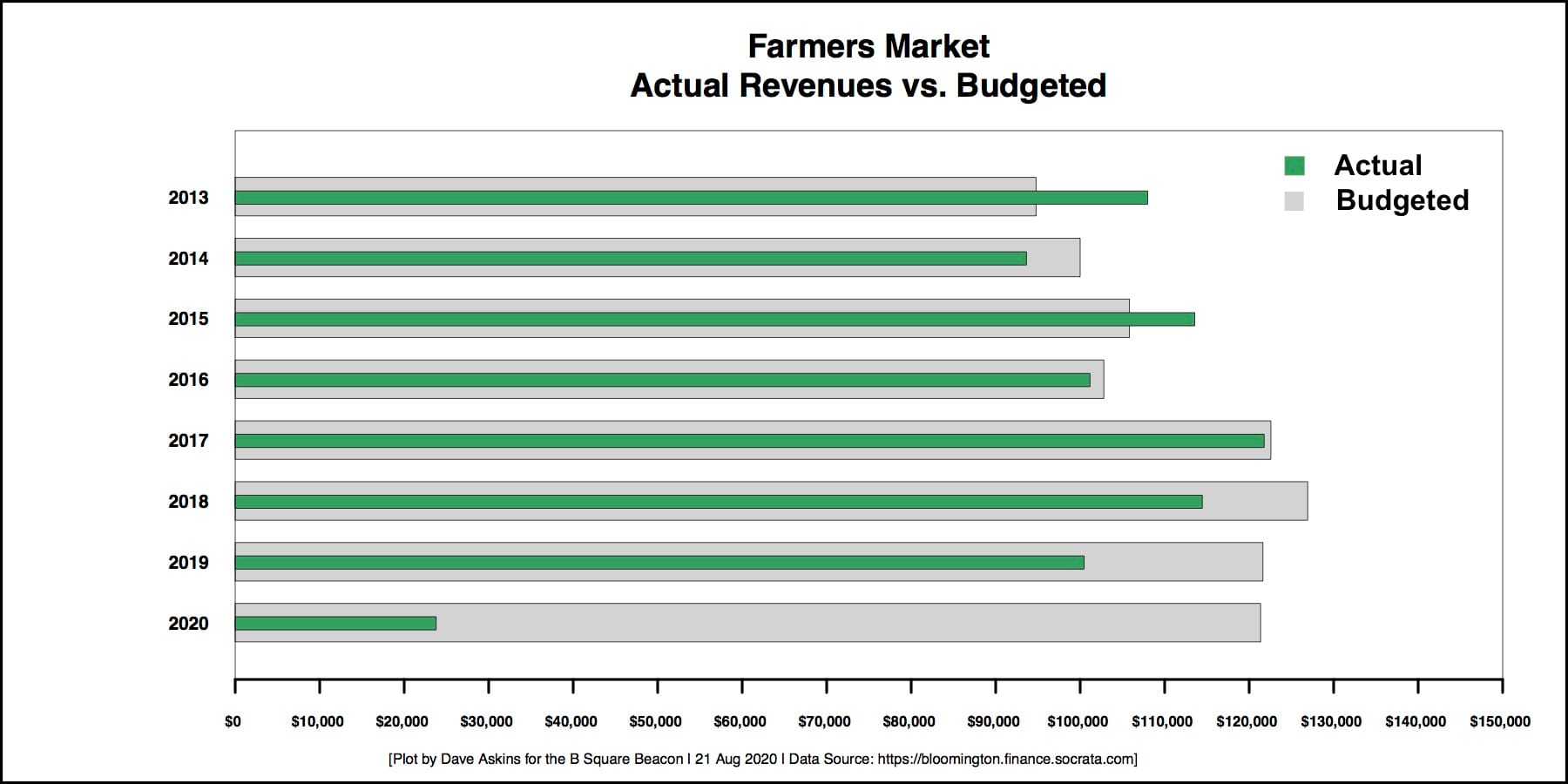
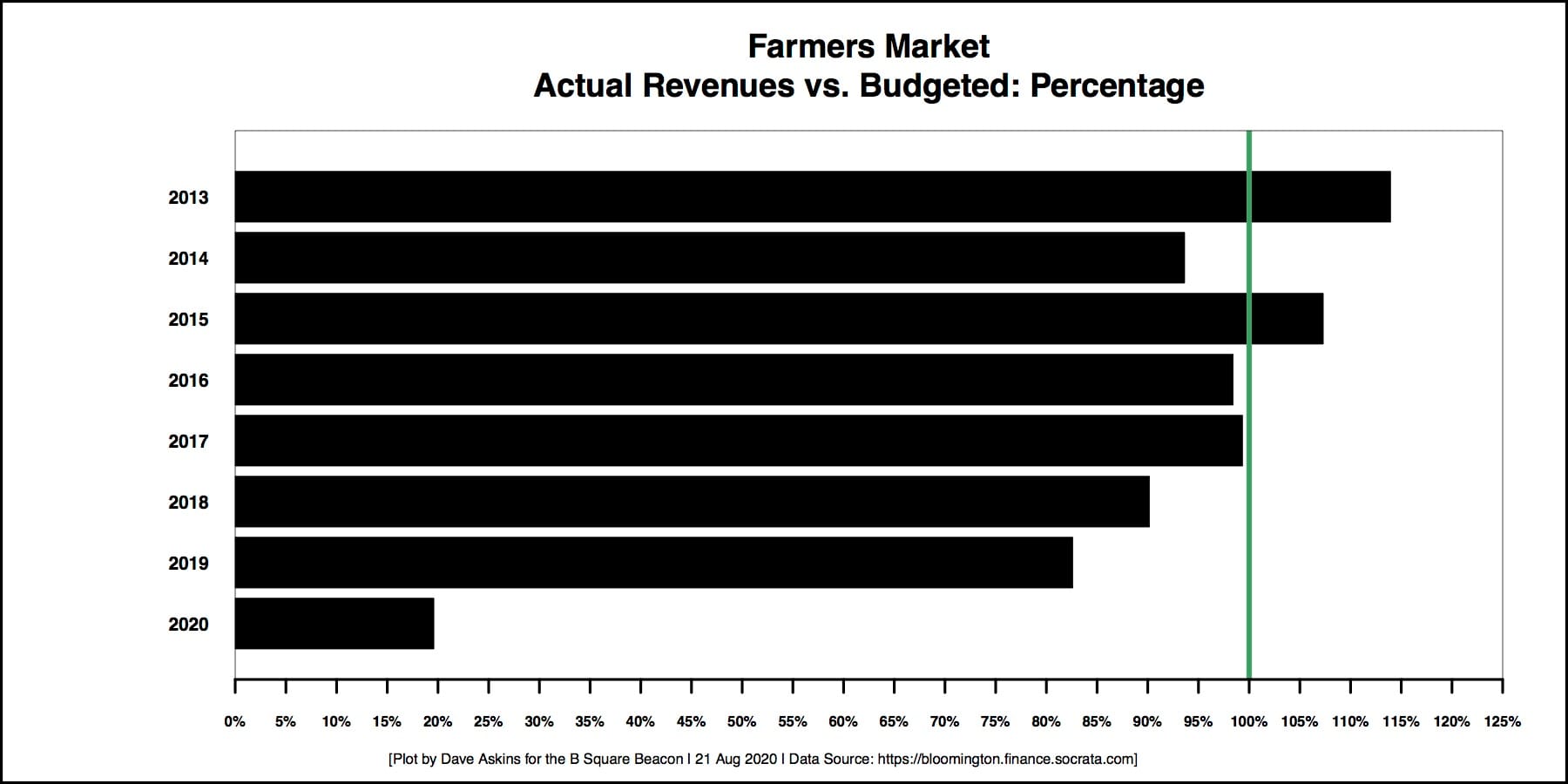
Based on the farmers market revenue numbers so far this year, sourced from the city’s new online financial system, it will be a grim picture at the end of the season. Comparing actual revenue with budgeted revenue is not the same kind of calculation that’s done for cost recovery, but is still useful for assessing the financial situation.
So far this year, more than halfway through the season, revenues are around $24,000 compared to budgeted revenues for the whole year of about $121,000. Stall fees for farmers were waived initially, when the season opened in the context of a statewide stay-at-home order.
The final revenue number for the 2020 season will be more that the current figure, due in part to the way the fees for food and beverage artisans are structured. They pay a percentage of their sales—7.5 percent this year. That’s a reduction from the 10 percent they’d paid in previous years, based on a decision of the board of park commissioners made this spring.
Food and artisan vendors had wanted the rate set at 5 percent this year, with an eye towards eliminating the percentage-based fee, replacing it with the same kind of fixed stall-rental price used for farm vendors.
After a mid-June announcement from the owners of Muddy Fork Farm & Bakery that they would no longer be selling at the city’s farmers market, the revenues from Muddy Fork’s percentage of sales are not in the future mix.
Based on city records, in 2019 Muddy Fork, paid $12,330 in fees, when the rate was 10 percent of sales. That’s more than any other vendor, and about 14 percent of the fees paid by all market vendors combined that year.
Based on numbers from the city’s new online city financial system, Muddy Fork has done more business through the city’s new online ordering system than any other vendor so far this season. As of last week, payments through the system to Muddy Fork are about 50 percent more than the next busiest vendor, which is Olde Lane Orchard.
At Wednesday’s city council budget hearing, the farmers market didn’t get much commentary from councilmembers. Piedmont-Smith reiterated the position she’d taken on Monday, when the legal department presented its budget: She thinks it’s time for the city to get out of the farmers market business.
On that occasion, Piedmont-Smith’s council colleague Dave Rollo offered an opposing view: “I respectfully disagree. I think that the administration is doing the appropriate thing in maintaining a public space, which we seem to be running out of in our society, and so I appreciate their efforts.”
On Wednesday, no one besides Piedmont-Smith ventured an opinion on the topic. Piedmont-Smith said, “It seems to me that at this point, the city of Bloomington, the residents of our city, are probably better served if the community farmers market is run by a nonprofit organization.”
Piedmont-Smith added, “Currently, at the farmers market, as we know, there’s a vendor who has ties to white supremacists and it just has created an atmosphere where a lot of people do not feel safe going to the market. And of course, due to the First Amendment, we, as a government, cannot restrict or deny that vendor if they follow the other regulations.”
Piedmont wrapped up by saying, “I think it’s time for the city to get out of the farmers market business, just on principle.”
Councilmember Jim Sims has previously expressed his support of the Black Lives Matter B-town core council’s call for a boycott of the city farmers market.
Any decision on the nine-member Bloomington city council requires at least a five-vote majority.




Comments ()